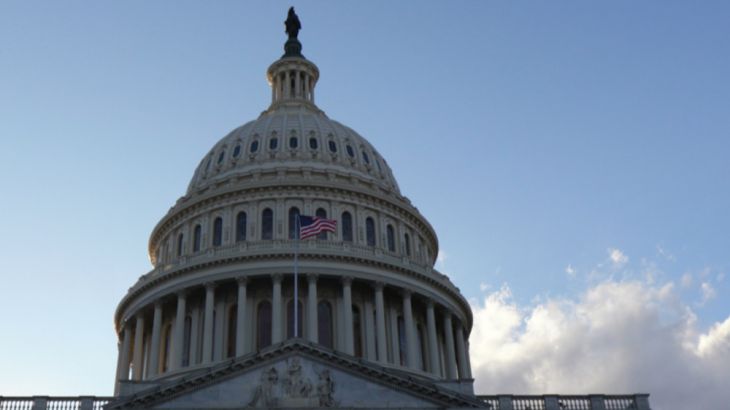
Life of the Party: American Politics in the Trump Era
A year into the Trump administration, how have GOP and Democrat identities changed and what does it mean for the US?
It’s been just over a year since Donald Trump won the US presidential election and shook the country and its political system to the core.
Since then, he’s managed to upend nearly every political convention, with his unpredictable statements and tweets throwing both Washington and the country into chaos almost daily.
Keep reading
list of 4 itemsThe Take: Trump v United States
Witness testimony continues in Trump’s New York hush money trial
Six takeaways from Trump immunity hearing and New York hush money trial
He’s also left both major political parties in tatters, with their identity blown to pieces. The turbulence Trump has brought to Washington has forced both Republicans and Democrats to question who they really are.
Both parties do have an identity crisis right now. And, if nothing else, Trump has clarified the battle lines.
“These two political parties are intellectually exhausted and it’s not clear what either of them stands for. I think most Nebraskans think that these parties are really uninspiring and unimpressive and we need to do some fundamental reworking of things in this country,” says Nebraska Republican senator Ben Sasse.
In their trade for power, the Republicans lost control of their party to Trump, and the far-right of their voter base. Trump’s public blow-ups with members of the Republican Party (GOP) have not gone unnoticed, either. Most recently, a Twitter feud with Tennessee senator Bob Corker made international headlines, underscoring how fragile the party’s foundation has become.
Corker, an old golfing acquaintance of Trump’s, made statements as to the White House becoming an “adult daycare centre”, alluding to tweets from the official POTUS account around the escalating sensitivities between the US and North Korea.
“You would think he would aspire to be the president of the United States and act like a president of the United States,” said Corker. “But you know, that’s just not going to be the case, apparently.”
The ongoing sexual misconduct debacle with Alabama senate candidate Roy Moore has also demonstrated deep distrust and differences within the Republican party, with traditional establishment Republicans and far-right branches of the party taking opposing stances.
Moore, a former Alabama state judge, is known not only for the recent misconduct allegations, but also for being twice removed from the prestigious position for disobeying Supreme Court decisions. These include same-sex marriage legislation and taking down a statue of the Ten Commandments he had installed in a government building, claiming he wanted to “bring God back into law”.
He’s also rallying voters on one of the country’s most divisive issues – undocumented immigrants.
Moore may be on the political fringe, but, in a lot of ways, he fits the model Trump built: A firebrand candidate who wasn’t backed by party leaders, but, in a field of establishment candidates, Republican voters made him their nominee.
“The Republicans aren’t fighting a civil war on policy. I think these senators recognise… the party that they represent is changing underneath their feet as we speak, and they realise that you can’t criticise Trump and all the things he stands for and all the positions he has they don’t agree with, and win a Republican primary. It really is an identity crisis,” says Amber Phillips, a staff writer for the Washington Post.
As the Republicans try to figure out what their party is turning into, this year has also been full of challenges for the Democrats, with the party yet to fully come to terms with how and why Hillary Clinton lost. In the lead up to the elections, almost every major vote forecaster in the US had placed a Clinton win in the 70-99 percent range.
However, the Democrats had uncovered their own party divide long before the dramatic loss, when self-described Democratic Socialist Bernie Sanders managed to seriously challenge a politician as established as Hillary Clinton. Clinton’s brand of Democrat is described as a kind of left wing, compromising Republican, while Sanders represented the concept of an “idealistic left”.
Sanders seems to have revealed some of the inner desires residing within Democratic voters, but the problem for party leaders is how to reconcile that in the Trump era.
“They definitely want to say they’re not Trump. But, do they want to say also we are something really different? Here’s who we are. And that’s what they’re wrestling with. Do you just run against Trump? Or do you literally stake out a set of positions that offer you as a clear alternative, not just to Trump but to the politics that gave you Trump? And that’s a much deeper, much more fundamental thing,” says John Nichols, national affairs writer for The Nation.
Fault Lines examines how Donald Trump has impacted American politics and the fractures he’s exposed in the country and its political parties. We also look at the loss of identity of both the GOP and Democrats, and look at what their strategies for rebuilding mean for the country’s political future.